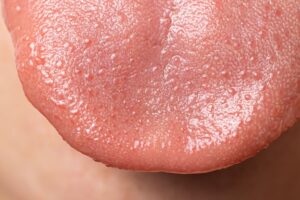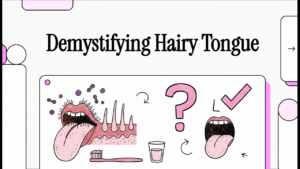1. What is Hairy Tongue? A Reassuring Overview
This guide provides clear, easy-to-understand information about a common and harmless condition called hairy tongue. While its appearance can be surprising, and in some cases may be associated with bad breath or a tickling sensation, it is important to know that the condition itself is not dangerous and is usually temporary.
Hairy tongue is a temporary condition that occurs when the tiny bumps on the surface of your tongue, called filiform papillae, grow longer than usual. Normally, these papillae are short and are shed regularly. When they don’t shed properly, they can accumulate debris, bacteria, and yeasts, leading to the characteristic “hairy” look and feel.



Podcast:
Learn More About Hairy Tongue
Common Characteristics:
- Unusual Appearance: The tongue develops a “hairy” coating due to the filiform papillae becoming elongated, sometimes growing up to 18 mm in length.
- Discoloration: The elongated papillae can become stained by food, drinks, or bacteria, causing the tongue to change color. The most common colors are brown or black, but yellow or green discoloration can also occur.
- Location: This condition typically appears on the top surface of the tongue (the dorsal surface). The tip and sides of the tongue are usually not affected.
Most importantly, hairy tongue is a harmless, self-limiting condition that typically resolves on its own with simple care and attention to oral hygiene.
2. Understanding the Cause: What’s Happening on Your Tongue?
Understanding what causes hairy tongue can help demystify the condition and is the first step toward managing it effectively. The development of hairy tongue is not an infection but rather a build-up issue on the tongue’s surface.
The process begins when the surface cells of the filiform papillae do not shed as they normally would. This causes them to become longer and creates a matted texture that can trap debris, such as food particles. This environment allows for an overgrowth of bacteria and yeasts. These microorganisms can produce deeply colored compounds called porphyrins, which are responsible for the brown, black, or other discoloration seen on the tongue.
This underlying process is often triggered by specific habits or factors, which are important to identify and address.
3. Key Risk Factors: What Increases Your Chances?
Identifying the factors that contribute to hairy tongue is a key part of managing it. Many of these factors are related to lifestyle and daily habits, which often means you can take direct control of resolving the condition by making simple changes.
Lifestyle and Hygiene Factors
- Oral Hygiene & Habits
- Poor oral hygiene
- Smoking or chewing tobacco
- Excessive alcohol consumption
- Cocaine use
- Using mouthwashes that contain chlorhexidine or peroxide
- Diet & Hydration
- Regular consumption of colored beverages, such as coffee
- Dehydration
- Hyposalivation (a clinical term for dry mouth)
Other Potential Factors to Discuss with Your Doctor
Certain medications (such as certain antibiotics like penicillin and tetracycline, or medications containing bismuth) and medical treatments like radiation therapy are also known risk factors for hairy tongue. It is crucial that you never stop taking a prescribed medication without first consulting your doctor.
By recognizing these risk factors, you can begin to take practical steps toward treatment, often starting with simple adjustments to your daily routine.
4. At-Home Care: Simple Steps to Resolve Hairy Tongue
The treatment for hairy tongue is usually straightforward and focuses on gentle, consistent at-home care. In most cases, prescription medications or intensive procedures are not necessary. The goal is to address the underlying causes and gently remove the build-up from your tongue.
- Enhance Your Oral Hygiene: Improving your overall oral hygiene is the primary approach to treating and preventing hairy tongue. This includes regular and thorough brushing of your teeth.
- Gently Clean Your Tongue: Gentle debridement, or cleaning, of the tongue’s surface helps remove the elongated papillae and trapped debris. This can be done with a tongue scraper or a soft toothbrush. You can also use a solution of 3% hydrogen peroxide or baking soda to aid in the cleaning process.
- Avoid Contributing Substances: Avoid mouthwashes containing peroxide or chlorhexidine, as these can contribute to the condition. However, your dentist may recommend a different type of antiseptic mouthwash as part of a treatment plan if needed. It is also advisable to stop smoking and reduce excessive alcohol intake.
While these at-home measures are effective for most people, some persistent cases may require additional help. If your condition does not improve after a few weeks of consistent care, your doctor or dentist can discuss other options, such as prescription topical treatments, to help resolve it.
5. Key Points to Remember
Here is a summary of the most important information to remember about hairy tongue. Understanding these key facts can provide peace of mind and guide your actions.
- It’s Harmless: Hairy tongue is not a dangerous or contagious condition. Its appearance is the main concern, but it does not pose a threat to your overall health.
- It’s Temporary: The condition is described as “self-limiting,” which means it typically resolves on its own, especially once contributing factors are addressed.
- Hygiene is Key: The most effective treatment is improving your oral hygiene routine, which includes gently cleaning your tongue daily with a scraper or soft-bristled toothbrush.
